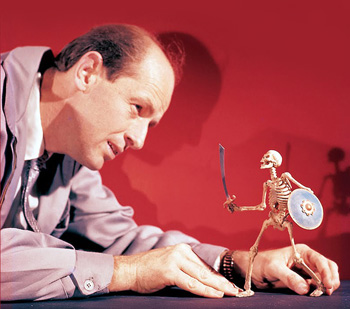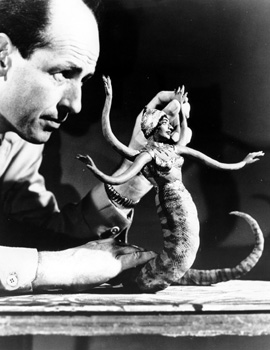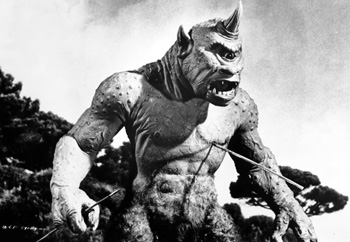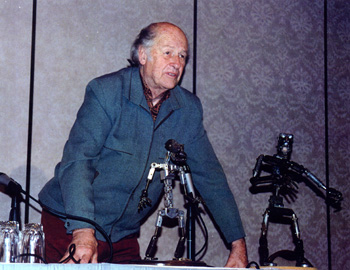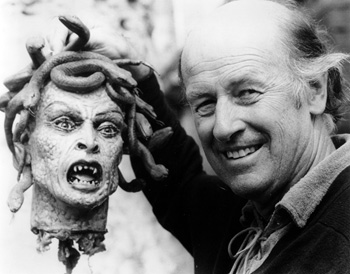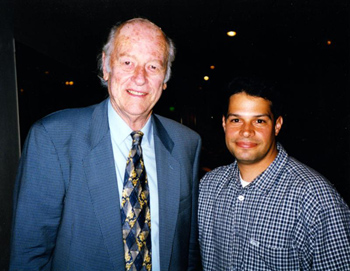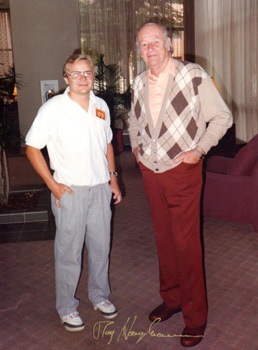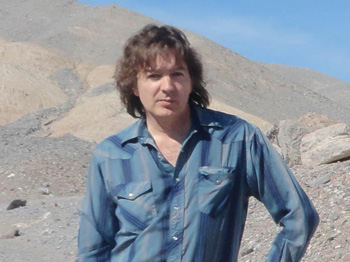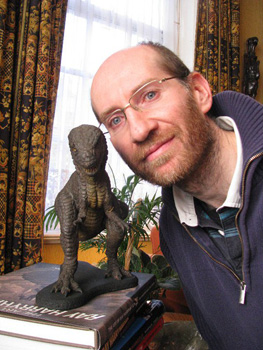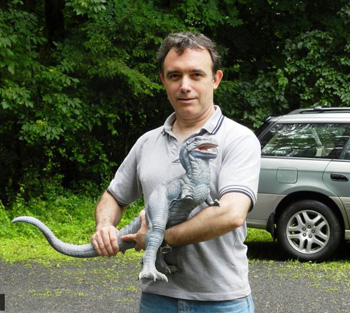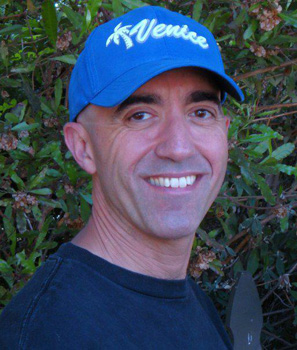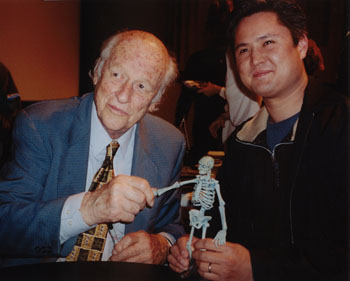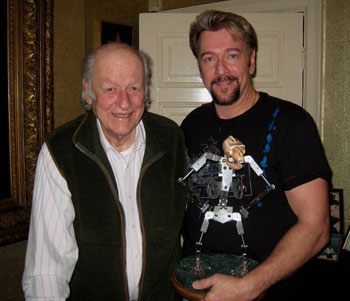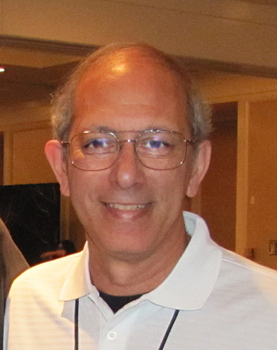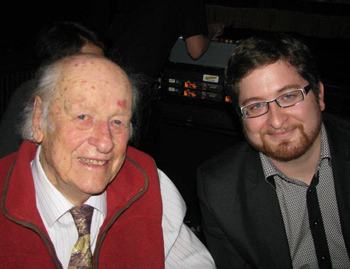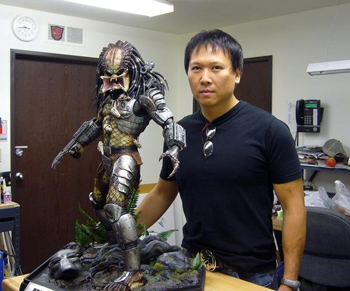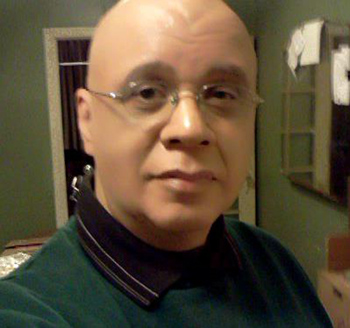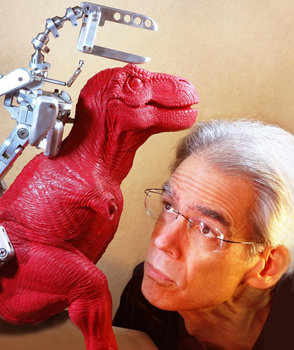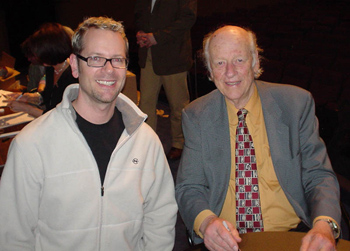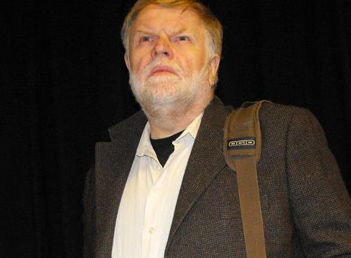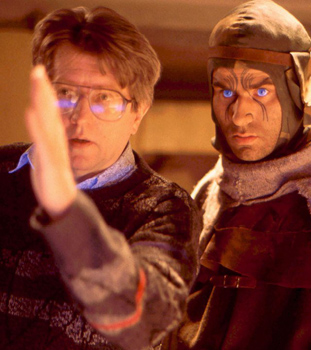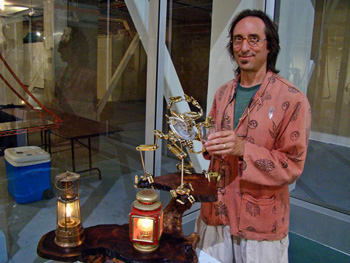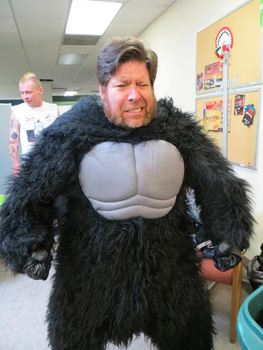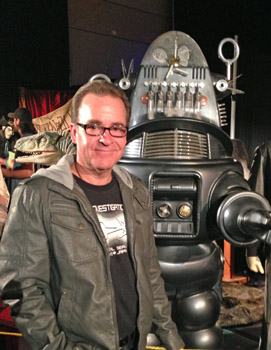Authors: Loren Portillo, Sean Kotz Photos courtesy of Loren Portillo
Ray Harryhausen, the pioneering filmmaker and special effects master of such classic films as THE SEVENTH VOYAGE OF SINBAD, VALLEY OF GWANGI, and JASON AND THE ARGONAUTS, passed away peacefully Tuesday May 7th in London England from an undisclosed illness. He was 92 years old. With Ray Harryhausen’s passing came an instantaneous ritual litany of recognizable names testifying to his influence -- Steven Spielberg, George Lucas, Peter Jackson, James Cameron, to name a few. But by the same token, there was practically no real discussion of why he had that impact. That’s predictable, really. For most people, this is just a news sidebar, including the legions of web-bound entertainment beat writers frantically culling fragmentary and unchecked sources to adopt a posture of authority for his impromptu obituary. Harryhausen is simply not familiar to most of the new breed of writers cluttering online news services and blogosphere. He outlived his career by 30 years, and for the bulk of the obit writers, his death detoured them from their real concerns, like whether Mylie Cyrus is hotter than Lindsey Lohan. But, the simple fact that Harryhausen’s death resides largely on entertainment pages betrays how poorly his contributions are understood. If Spielberg dropped dead tomorrow, it would be a front page story because even disinterested people realize he is a historic figure, a sculptor of culture. Harryhausen should get the same treatment, of course, but does not, because few people in mainstream media really get what he meant cinematically, culturally, and historically. So... let’s set that straight. Harryhausen Invented a Genre
As crass as the observation may be, Harryhausen films (which is the way people refer to them) generally made good money over their investments. In realistic terms, no matter how great he may have been as an artist, if Harryhausen’s films had not made money, you would not be reading this now. Simply put, the film industry is just that -- an industry-- and it does not offer too many second chances. Because he got it right the first time, and made money for investors, we have the giant monster genre today. Harryhausen’s first solo film as an animator was THE BEAST FROM 20,000 FATHOMS in 1953. The film was an independent project shot for $210,000 and sold to Warner Bros. for $400,000, which sank another $200,000 into publicity. However, it went on make more than $5 million in its initial release and significantly more in additional revenue as the years wore on and films went into rerelease, VHS, DVD and now Blu-Ray. The financial success of that film launched the giant monster genre, inspiring not only future Harryhausen creations like IT CAME FROM BENEATH THE SEA and 20 MILLION MILES TO EARTH, but also a string of giant bug, lizard and monster films that by comparison, reveal the genius of Harryhausen. To some degree, we might even see Harryhausen as an accidental father of the daikaiju genre as well. As the story goes, when GODZILLA producer Tomoyuki Tanaka’s proposed film IN THE SHADOW OF GLORY fell through, he was inspired to create his own giant monster film in part because of the international financial triumph of THE BEAST FROM 20,000 FATHOMS. Without Harryhausen, there might never had been a Godzilla, Rodan or Mothra, or the millions of dollars they have generated. Harryhausen Perfected the Motion in Stop Motion
Harryhausen’s primary contribution to film is not through a single character or movie but rather through his gift for careful rendering of motion with physical, inanimate models. His dinosaurs, monsters and fantastic creatures move as we would expect them to in a real physical environment. This lends believability, to be sure, but more than that, it allows the spectator to accept the whole world, including its story and human characters, easily. We can see this as early as his work in MIGHTY JOE YOUNG. While his mentor, Willis O’Brien of KING KONG fame, was the “technical creator,” Harryhausen estimated that about 85% of the animation was his work. In many ways, Joe surpasses Kong as an example of stop motion. Compare, for example Kong’s climb of the Empire State Building to Mighty Joe’s passage up the tree near the end of the film. Both stop along the way and make believable gestures, but Joe’s body swings more naturally, suggesting realistic weight and the fluidity of natural motion that real apes possess. The sense of gravity and natural motion became more important as movie technology developed and audiences grew more sophisticated. Consider, for instance, the importance of proper motion in a flying creature -- we see birds, insects and bats all the time, so we intuitively know how they operate. Harryhausen’s harpies, the Roc and his various pterodactyls demonstrate lift when the wings pick up speed and sag as they lower their beating. In truth, no one -- not even Willis O’Brien -- did this as consistently well, and by setting a new standard, Harryhausen made otherwise untellable stories possible by immersing us in the reality of the world we witness because the physics of that world is the physics of ours. Harryhausen Transformed Lifeless Models into Characters
As a byproduct of this realism, Harryhausen accomplished an even more remarkable thing -- he transformed his models into characters with expressions, gestures, motivations and identities... even if that subject was a dinosaur or monster. Perhaps the best example is his beloved Ymir from 20 MILLION MILES TO EARTH. Harryhausen fans frequently wax poetic about this film, but in all honesty, it features some of the worst dialog and acting in the entire 50s “Monster on the Loose” genre, and that is saying a lot. Even the reasonably talented William Hopper and Joan Taylor are hamstringed with wooden lines and a stagey ensemble cast. And Pepe, the Texas obsessed faux-Italian waif, is unbearably bad. But, no one really remembers this about the movie because the Ymir is the real star. We follow his (or her?) birth, entrapment, torment, quest for freedom, and final unpleasant end, not the love story or combat imperatives. The Ymir had an anthropomorphic body that reacted the way the human body would to attacks, but he also had a face with just enough human similarities to allow us to emotionally attach to his story. In essence, the Ymir became Harryhausen’s Kong and the subtle animation reveals more of the Harryhausen genius. In his autobiography, An Animated Life, Harryhausen wrote, “Although these creatures must always die, they should go out with a touch of pathos.” Clearly this was part of his philosophy as an artist, and he applied lessons he learned from acting classes to the creation of his characters. Even Gwangi and the Rhedosaurus exhibit these qualities of character, which is why the films can still resonate. Harryhausen Understood Cinematic Storytelling
It might be hard to believe today, a time when sound in film is generally mixed specifically to be overbearing and compensate for poor storylines, uninteresting characters and visual clichés, but in the early days of the transition to “talkies” a very serious debate raged as to whether cinema with sound was really cinema at all. Watching a film designed without sound, especially without inter-titles or even a sound track, promotes a very different mental experience on the part of the spectator. A different level of engagement that is more purely “cinematic.” As an animator, Ray Harryhausen understood the cinematic. To some degree, most of his sequences rely on visual storytelling. But consider what is arguably his true masterpiece: ONE MILLION YEARS B.C., a film without true dialog. While we have the “diegetic” sound of the dinosaurs and a fair amount of percussive music, the film is about as close to a pure visual experience as you can get after the rise of the talkie. His dinosaur battles rage for several minutes at a time and their thrusts and parries, leaps and tumbles occupy the screen through several types of shots -- cuts from wide to medium to close up; cuts to inverse perspectives; shots framed through rock crevices and foreground foliage. This indicates that Harryhausen created not just a technical achievement but employed a cinematic language and exemplifies why John Landis frequently referred to him as a true auteur. Harryhausen Activated the “Childmind”
Harryhausen’s films have a rather rare ability to appeal to adults and children at the same level. Today, kid’s films are typically designed to have a little something in them “for the grownups,” but that is not the same as creating a parallel appeal. What we most miss about our childhood when we grow older is the tremendous freedom of mind that comes with play and wonder. Harryhausen, more than any other animator (or director or producer) of his time, knew how to tap into that. And it is important because fantasy, and its fraternal twin, science-fiction, invite our minds to open back up again, to see the world in a mythic and metaphorical way that has a serotonin releasing effect on the mind. In other words, fantasy can create joy like a drug, and stop motion in the hands of the master is what enabled that for a whole generation of future filmmakers. In the tribute documentary, THE HARRYHAUSEN CHRONICLES, Harryhausen acknowledged this, saying that fantasy is really a type of dream world and what we want is an interpretation, not realism: “Stop motion, to me, gives that added value of a dream world that you can’t catch if you try to make it too real. And that is the essence of fantasy, isn’t it? Transforming reality into the imagination.” Note that Harryhausen does not espouse turning the imagination into reality, but rather, taking the raw materials of reality and elevating them into fantasy. If I may insert a personal note here, several years ago, after watching THE VALLEY OF THE GWANGI with my son, who was a teenager at the time, I remarked that of course, CGI offered a more realistic brand of special effects. My son replied, “Yeah, Harryhausen’s work isn’t as realistic, but it is cool.” He emphasized the word “cool” in a way that expressed it as a superior quality and a product of imagination and genius.
Remembering Ray Harryhausen
Loren Portillo, Stop Motion Collector/Historian
I received the news of Ray`s passing from my friend, Visual Effects Supervisor Randal William Cook. And like most of those who had heard the news on various social networks, I was stunned as well as very saddened. With the passing of Mr. Harryhausen, it truly marks the end of an era of one of the last great special effects men of our time. As tributes have been pouring in from various news outlets, I have heard the word "technician" often used describing Mr. Harryhausen and his work. I disagree with that assumption. Ray Harryhausen was an artist extraordinaire whose paint brush was the art of stop motion photography. He was a singular person whose brush strokes of genius would take a small articulated puppet and breathe life into it like no other and in doing so created some of the most spectacular animated sequences in film history. For over forty years, science fiction and fantasy film audiences marveled at the astonishing animated sequences that Ray Harryhausen created in his films. Working on extremely tight budgets, Ray would never shy away from giving his audience what they deserved. That was the gift that Ray gave us all. From a lovestruck dinosaur destroying a light house, to a one eyed cyclops attacking men on a beach, Ray Harryhausen fueled our imagination like no other filmmaker. Inspiration is the word I have often heard describing Ray and his work. The list of filmmakers he has inspired is well documented.... Steven Spielberg, James Cameron, George Lucas just to name a few. But I have often said it’s the filmmakers that are not as well known to the general public that Ray`s inspiration and legacy made the most impact. Names such as Randy Cook, David Allen, Phil Tippett, Jon Berg, Dennis Muren and so many others are what I have often described as "Harryhausen`s Children" or the "Children of the Hydra`s Teeth". Many of the filmmakers that I have mentioned, have gone on to win multiple academy awards and have developed innovations of their own such as present day computer graphics. These men were inspired by Ray Harryhausen at a very young age and their careers were shaped by his incredible body of work. And we are so very lucky because of it. On another more personal note, I too had been inspired by Mr. Harryhausen. As a garage animator as far back as twelve years of age, I remember watching many of Ray`s films on my crappy b&w TV and being awed even though those images would appear on a 9 inch screen. I was not a very good animator per say, but that did not matter to me. Since I was inspired to be like my hero Ray Harryhausen, I was able to create my own puppets and animated them on my miniature sets. That`s all I wanted to be. I cherish those memories. In later years I would do less animating but would collect memorabilia on the art of stop motion animation. That has become a life-long passion of mine to this day as well as forming friendships with fellow animators and collectors for which I am eternally grateful too. Its your fault Mr. Harryhausen. :) In closing I have had the great honor of meeting Mr. Harryhausen on several occasions at various film functions over the last 25 years and I feel truly blessed to have done so. Ray was such a friendly, kind man with an incredible sense of humor. I can still hear his familiar baritone type voice cracking jokes and having fun with his audience. I am so glad he was able to bask in the glory and feel the love he so well deserved from his fans and friends. I would also like to personally thank Arnold Kunert who was Ray`s friend and helped Ray and his wife Diana when they made appearances in the U.S from England. It was Arnold who spearheaded the campaign to get Ray his star on The Hollywood Walk of Fame as well as other awards and honors. Ray`s fans owe you and your wife an enormous debt of gratitude. Thank you so much, Arnold. And to Mr. Ray Harryhausen: As many more testimonials will appear on this website, words cannot fully express what you and your career have meant to me. Your dedication to your art as well as the kind human being you were will be missed always. I thank you for making my childhood such a memorable one. You’re in the hands of the gods now... Greg Kulon, Stop Motion Historian
Ray`s images inspired because they were bold and dynamic, his creatures had real character, and you could see them with an impressive otherworldly clarity that made them stand out. Other artists and creature creators of less talent may have hid them in shadows or cut corners, but Ray`s were filmed the way you would want to see them if they really existed. These images always stuck with me, and I wanted to capture them forever, first with stills and Super 8mm films, and then later in posters, artwork, and sculptures. My fascination even had me plan our Honeymoon to Europe with a special stop just to get a view of an exhibit of Ray`s work in Germany (and having to make it up to my wife with a finale in Paris!). Ray`s films broadened my outlook, as I am sure they did many others. It may have started with touring art museums and searching for classical predecessors to his creations. Finding them wasn`t always difficult, and rarely were they designed as well as Ray`s characters. Ray would make you look at art differently, and discover the beauty of the lighting in a painting or the intricacy of a Dore etching. How many of Ray`s fans discovered classical music after falling in love with the Bernard Herrmann scores for his films, or started reading classic literature after journeying with Ray`s interpretations of Swift, Wells, and Verne? I know many of us did. Talking with Ray about his idols and influences, be it Obie/King Kong, Gustave Dore, or Laurel and Hardy, was always a revealing experience. Very few people of his renown would even return a letter, let alone open their house and share candid memories with a fan. But Ray was always willing to share his time and experiences, if not the detail of his bag of tricks. With all that though, possibly my most cherished memories of Ray involve sitting in a dark theater where Ray was in attendance soaking up the love and applause of his fans when his name appeared in the opening credits. He knew we cared about him and his art, and we were ready to get our fix for the next few hours. Enjoy your reward in eternity Ray, it is deserved! Richard Kent Burton, Animator
Around 1969 I started making flipbooks and showing them to my classmates. Since I had been drawing from the age of five, this was a next step. I wanted to be a cartoon animator! By the eighth grade I was watching FIRST MEN IN THE MOON when one of my friends told me the monsters were animated using models. All those other movies with that mystery technique were suddenly answered. My love of monster movies found the perfect mate with animation and I had no question where I was heading. I completely removed the reality from my mind that almost no one gets in the business, especially back then. Luckily there were Ray Harryhausen movies to keep us inspired. Of course the only ways to see them were to skim the TV Guide every week or catch the rare showings at the theater. As my career moved into the eighties I had to disregard the beginning of the “Is Stop Motion Dead?” articles, and the worst of all: “A Creative Alternative to Stop Motion; Hand Puppets”...HAND PUPPETS!! Ray had already bailed from the industry and I could see why, but it was his work that kept us diehards going. There was the next wave of Harryhausen-type animation that kept up the hope of this art form’s longevity, but the scenes got shorter and shorter until it seemed that stop motion had been quarantined to “puppet only” films while computer animation took the Harryhausen torch. The indie market seems to be the proper avenue to take in order to entertain the remaining fans but films rarely get funded now as the industry tries to figure out the new market. There are some of us that want to continue the Harryhausen tradition with modern techniques that add more realism, but as far as being the “next Harryhausen”, there can only be one and it is Ray. He was there at just the right time, and he took all the right steps until his retirement. Like Jason, it seems he had everything laid out for him in advance and just had to pass every test. It’s almost inconceivable that he could do as much as he did, and on time. There are zillions of things that inspire me, but Ray’s work is the biggest inspiration for me, and probably because there is so much of it. Personally, my best experience with Ray was when Steve Chiodo and I met him and his wife at IWERKS to view a big dinosaur piece in a real environment that I animated most of. It was a circular screen that went all around us with the sound cranked up. Ray’s expression during it and what he said to me after was more than I expected. For one moment I got to “get him back” for the wonder he put in our eyes year after year. The legend is gone, but his work is well preserved for us for years to come. Although I feel a big empty spot in my chest from his passing, I am so thankful that he had a long and wonderful life. I wish we could all know what his next destination is. Giles Penso, Filmmaker
A giant bronze statue, motionless on his titanic pedestal, which suddenly turns his head slowly to reveal a terrifying blank stare. This is my first contact with the work of Ray Harryhausen. This impressive and surreal vision, from the masterpiece JASON AND THE ARGONAUTS, symbolizes to me the body of work of this wonderful magician. He breathed life to immobile things. He gave a soul to clay. He created the impossible. This man was more than an animator, a special effects wizard, a filmmaker or even an author. He was a poet. And his poetry has never ceased to populate my childhood dreams. Today, this delightful man, charming and full of humor, left us. But his amazing creations will continue to make us dream until the end of time. Farewell Ray, we love you.
Joseph Laudati, Sculptor/Stop Motion Animator
I first encountered the magic of Ray Harryhausen when I was less than three years old. It was a Thanksgiving viewing of MIGHTY JOE YOUNG on Channel 9, immediately followed by a repeat of KING KONG. In my young mind, I actually thought Kong was a sequel to Joe Young, and I couldn`t figure out why the lovable ape was now so mean and scary. Ray’s effects would again enthrall me a few years later, when I saw ONE MILLION YEARS B.C. The prehistoric epic was a bit intense for a five-year-old, but that allosaurus sequence left a mark in me as deep as Tumak’s spear. In the years to come, my brothers and I discovered the rest of Ray’s films, and they drove us to experiment with our own stop-motion spectacles. He was the driving passion in all our careers, leading my older brother Tony to work in the creature shop at ILM, and me to my own illustrious profession as a fantasy sculptor. I’m grateful for the many opportunities I’ve had to immortalize his menagerie of beloved characters. Tony Laudati, Animator
I still can`t believe he`s gone. Ray Harryhausen had an immense impact on my brothers and me while we were growing in Upstate New York. Our introduction to Ray came in the form of Famous Monsters of Filmland Magazine. One issue had a black and white profile of the Cyclops, but only from the waist up. When we finally watched 7TH VOYAGE OF SINBAD for the first time on our new color TV, you can imagine our surprise, when the Cyclops comes out of the cave, to see that the creature had goat legs! Ray`s Film Fantasy Scrapbook, which we ordered through my parents` book club, had us permanently enamored with Ray and his artistry. We swiftly went on to build our own models and film animation shorts. We had the honor of meeting Ray at a convention in New York in 1983. He was warm, encouraging, and quite fatherly to us. I later went on to work at ILM as an animator and puppet builder on movies like COCOON, EXPLORERS and YOUNG SHERLOCK HOLMES. But with YOUNG SHERLOCK, my co-workers and I saw the writing on wall when, in the ILM screening room, we sat with Dennis Muren and watched the first tests for the computer-generated Stained Glass Man. Stop-motion and a lot of other time-proven effects techniques were on their way out. I am happy that I did have the opportunity to work for Art Clokey on the revived GUMBY TV show in the late eighties. It`s so sad that Art and now Ray are gone. But I still see Gumby toys and t-shirts. And Ray`s inspiration will live on in all of us and future generations. Steve Koch, Animator
I was lucky as a kid, I knew exactly what I wanted to be; I wanted to be just like Ray Harryhausen. His work was amazing. His characters were captivating. He did the parts of the movies that we all went there to see. Not only did he bring amazing creatures to life but he created amazing environments for them to inhabit. Ray inspired so much in my life and I`m grateful to have met and spoken with him. I owe him so much and I miss him.
Webster Colcord, Animator/Special Effects Technician
Like it happened for so many others, my head exploded at the age of 9 when I first saw the Cyclops charge out of his cave. I spent a week or so walking around in the crouched (arms-back) pose and shaking my body, trying to mimic the strobing effect. You know the story... later on I found Famous Monsters magazine and read the books about Ray. Like the others here, I embarked on the long process of learning how it was done, and learning how to mimic his work for real. I think I first met the master when Ray came to the Portland Creative Conference after his Oscar in 1992. Will Vinton was the major sponsor of the event, and Ray stopped by the Vinton studio and spent a good deal of time there with us over several days. He even paid a visit to the set I was animating on for a Play-Doh commercial. Wow. Over the years I`ve gotten to spend some time in his presence and my idolization of Ray as a God-like figure has shifted into the understanding of him as a very human craftsman who worked hard and made good choices. Not as a holy relic to be idolized, but as a fellow craftsman who caught the bug from a previous mentor -- the great Willis O`Brien. There are a lot of complex feelings when an artist of Ray`s stature passes. But over all, I`m just plain sad because, even though Ray didn`t know me by name, I`ve lost an animation buddy. Jeff Taylor, Armature Designer/Machinist
I wrote this after my visit with Ray a couple of years ago: TWO HOURS WITH A LEGEND It was March 1, 2011. London, England. I arrived about fifteen minutes earlier than the scheduled time, so I waited outside for bit, taking in the atmosphere of the Kensington neighborhood. It’s a quiet, upscale location, reeking of history and reminding me very much of Boston, the city in which I grew up. I wanted to savor the moment, to get myself mentally prepared to spend some time with one of my true heroes and inspirations. I stared at the black case that housed the Mighty Joe Young armature, wondering if it would bring Ray as much pleasure as it would bring to me by giving it to him. Part of the fun was that Ray had no idea why I was there, so being able to surprise him with it made the visit even more exciting. As a Director of Photography for various television productions, I’m surrounded by A-list stars every day. I’m never star-struck or nervous... I quickly outgrew that emotion many, many years ago. But on this day, I was actually nervous. Very nervous. Ray’s influence on my art and my life is significant... no number of Nicholsons, DeNiros, or Scorceses have as much meaning for me. I sat there thinking about all the magical moments of celluloid history that had been created by the gentleman who lived just over the hedge behind me. I was awestruck. THIS IS REALLY GOING TO HAPPEN.The proper time was soon at hand, so I walked up the stairs to the doorway and was greeted by the smiling face of Tony Dalton, co-author with Ray of the many books they’ve released in the last few years. “Ray will be down in a few minutes,” Tony told me. He glanced at the black case that held the armature. He smiled, knowing exactly what was inside of it. He had helped to orchestrate this master plan to surprise Ray. No sooner did I step in the door than Ray himself suddenly appeared. He now walks with cane, but he still has the twinkle in his eye of man who is young beyond his years. He happily shook my hand, now dwarfed by his giant mitt, which felt like it still had the strength to crush mine like an egg. I tried to look around, to take in every inch of the classy Victorian style home, adorned with brass framed works of art everywhere, but I really couldn`t take my eyes off of Ray for very long. He is so charismatic and charming that you feel guilty not to pay him 100% attention every second. He quickly pointed out a new bronze sculpture that he had recently completed, and we then entered a sitting room of sorts. Ray sat on chair by the window and I sat on a nearby couch. I watched his eyes drop to the black case I was carrying, and then he looked up at me curiously. “Jeff has something to show you, Ray, but we can chat a bit first,” Tony said. “It’s something I’ve been working on for a long time,” I said. “I think it’s something you might be interested in,” I added. Ray leaned back and raised an eyebrow. Now he was very curious. He stared at me, as if he was trying to figure out what this stranger in his home was up to. I don’t think any conversation with Ray could be considered “small talk,” but we chatted a bit about things that did not relate to his work. He asked about my work and when he heard that I was from Las Vegas, he had a sly grin on his face. “We used to take secret trips to Las Vegas when I lived in California.” When I asked about what actually occurred during those trips, he replied, “Well, if I told you they wouldn`t be secret any more now would they?” We talked about CGI effects, the fast pace of editing in current films, that he had not seen the remake of CLASH OF THE TITANS and he told me that Willis O’Brien was a very jolly man. His daughter Vanessa soon joined us and she was just as warm and charismatic as her father. Finally, Tony mentioned that I had something to show Ray. I opened the black case towards Ray so that he could not see what was inside. I lifted out the Joe armature, still blocked from his view. Tony and Vanessa, however, could see it, and both gasped. I stood up and handed the armature to Ray, who happily sat it on his lap as Tony began snapping photos. “It’s Joe!” he exclaimed. He immediately started manipulating the various joints and I told him how true we had been to the original materials and measurements. “No hitches in THESE joints!” he said. He continued to pose and repose it, and finally settled on a pose in which the hands were resting on the hips. “I don’t like that pose,” Vanessa said. “Looks like he`s waitin’ for a bus. Put him in real Joe pose.” Ray ignored her... obviously no one, not even his daughter, could tell him what to do with an animation puppet. He continued to closely analyze the armature. “I thought we had wire toes? These are jointed.” I told him that the design was based on the original armature that Bob Burns owns and that those toes were indeed jointed. “Oh really,” he replied as he nodded his acceptance. “We had stops in the body hinges to limit movement,” he added. Well, he had me there. I consciously left off the tiny pins that were later added to control the animation of the spine. I explained that there was no documentation on the blueprints for accurate placement and since this armature was for display only, it looked and felt better without them. Again he nodded his approval. I was stunned that he would remember such a minor detail... an indication that Ray was still as sharp as ever. I shot a bit of video, Tony snapped a few more photos, and then Ray handed the armature back to me. “Excellent work. Even better than the originals. It would be a shame to ever cover it up,” he said. I told Ray not to hand it back to me. “That armature is yours Ray,” I said. He looked at me incredulously. “I didn’t fly 6000 miles just to show it to you.” Again, he looked at me like I was crazy. “Jeff made this for you, Ray,” Tony said. “Read the inscription on the base.” The inscription reads: “Presented to Mr. Ray Harryhausen, March 1, 2011 in memory of Jennifer.” He smiled after reading it aloud. “I loved Jennifer Jones. They were making DUEL IN THE SUN at the same time nearby. That’s why I called my favorite model Jennifer.” Of course we all knew that, but it was great hearing Ray tell us again. I explained to Ray that many years ago when I first met him at a convention (while he was holding Bob Burns’ Joe armature) he told me that everybody had a Mighty Joe Young armature but him. That comment had stuck with me and I had always planned to recreate a perfect replica for him. It took 15 years but it finally happened. “I’m rarely speechless,” he said. “Thank you. Thank you.” He stared at me with his piercing blue eyes, which now were a bit watery. “It’s my honor, Ray.” We set Joe on coffee table and headed upstairs to the most magical office on the planet. It’s three flights up, and Ray now rides a chairlift that takes him up to the top. “You two go on ahead. I’ll be up in exactly eight minutes. I’ve timed it,” Ray said. Tony and I ascended the stairs and as soon as I entered the office, it seemed very familiar to me. I’d seen it hundreds of times over the years in magazines and books. I studied those photos over and over, hoping to get tiny bits of information about Ray’s models. How big were they? How were they constructed? Now... suddenly... I WAS HERE... surrounded by the images that consumed my youth, all right at my fingertips. The next half-hour was a blur to me...a surreal experience to say the least. Everywhere I looked was a legendary creature: Gwangi, Trog, Medusa... my brain was on overload. Ray finally strolled in. “Eight minutes exactly,” he said smiling. I wish I could remember everything we talked about but I simply cannot. I was just too distracted by the treasures around me to make very many mental notes. Here’s what I recall: Most of the models show some evidence of decay, but they are all still in surprisingly good shape considering their age. They cannot be re-posed, however, since the foam has now hardened and would crumble if bent. One exception is the skeletons. Tony handed me one and it moved beautifully. I also rotated the body of one of the smaller flying saucers. Ray’s dad had machined these on a lathe in various sizes, and it was as smooth as silk.... amazing. Ray has one special glass case that is filled to the brim with tributes from his fans, mostly sculptures of his famous creatures. It’s clear that he does not take the devotion of his fans lightly. It would appear that he saves everything. Ray sat down at his desk and Tony told me an interesting story: a talented fan had recently sent Ray a beautiful resin version of the Cyclops... probably the best interpretation of Ray’s creature that anyone has yet done. When it arrived, it was badly damaged in transit. A week later, Tony saw it on Ray’s desk with absolutely no sign that it had ever been broken into several pieces. Ray had simply taken it into his workshop and fixed it. I examined it closely and sure enough, it was flawless. I looked at Ray and he gave me an expression as if to say: “No big deal.” It had been about two hours and I didn`t want to overstay my welcome, so it was time to go. Back down on the first floor, I again shook Ray’s powerful hand and gave him a hug goodbye. His daughter Vanessa also gave me hug and they all expressed their gratitude for the gift. I glanced at the Joe armature, still in the “waiting for a bus" pose, and I was finally relaxed enough to contemplate the fact that it was now in its rightful place: in the home of the man who brought its twin brother to life. I remember little of the flight home from London to Las Vegas. Whatever occurred in those hours took a back seat to reliving my time with Ray over and over again in my head. I was honored to be allowed to give back something special to someone who has given so much inspiration to countless generations of filmmakers and fans. Now, this is purely my fantasy, but I often envision Ray sitting at his desk after everyone has gone to bed... endlessly putting Joe through many of the old and perhaps even a few new poses. The now immobile foam puppets look on as Ray’s masterful hands continue to work their magic into the wee hours of the morning... Richard Catizone, Animator
Ray Harryhausen stands as a giant... to the field of animation, to fantasy films, to all of us who have been inspired by him and his work. His inspiration led me to fulfill my desire to be an animator. His continual array of visual wonders, and tricks to ponder, fueled my passion and curiosity. Seeing his work inspired me to develop my own skills in drawing, sculpting, molding, armature-making, animating, etc. Getting to meet him on a number of occasions, having him to dinner in my home, and having a correspondence with him over the years was very special to me. Ray was a very special person. There are many who have been much closer to him than I, and others who never had the opportunity. But I know they were inspired by him as well. I said to him at dinner that I didn’t think he realized how many of us he “fathered”. He feigned indignation and said, “Why whatever do you mean?”, and we all laughed. For those of us who are older, we had a new Ray Harryhausen film nearly every three years. And that was on the big screen, where you REALLY get the impact of his work. Ray gave us a truly magical childhood. And then after that, his inspiration gave thousands (or maybe millions) of us careers. We all would have loved to been able to work for or with Ray. In truth, I think most of us really wished we WERE Ray. He was a father figure to many of us as well, and we affectionately referred to him as “Uncle Ray”. I have seen many artists admired for their talents. But I believe Ray is far from just admired... in a very special way, he is LOVED by us all. Will "the Thrill" Viharo, author of A Mermaid Drowns in the Midnight Lounge and Love Stories Are Too Violent For Me
From the time I was a child, Ray both sparked my imagination and inspired my own creativity with his innovative techniques, painstaking devotion to detailed craftsmanship, independent boldness, and vivid realization of fantastic concepts. I remember seeing ONE MILLION YEARS B.C. and VALLEY OF GWANGI at the drive-in when I was barely a sentient being, and being completely enthralled and captivated by the miraculous monsters onscreen (only later did I realize the amazing Raquel Welch was actually human, not a stop motion model...). Years later, as a film programmer and impresario with my own live theater show, Thrillville, I was able to book 35mm prints of all his masterpieces, and share them with fellow fans while introducing them to young audiences on the big screen, which is the best possible way to enjoy them. As a pulp fiction author, Rays unique visions continue to influence my own inner worlds of wonder. He made all of our wildest dreams come to life. Thank you, Ray.
Alexandre Poncet, Producer/Composer of RAY HARRYHAUSEN – SPECIAL EFFECTS TITAN
Having worked closely with the Ray & Diana Harryhausen Foundation for the last three years, I was told about Ray`s passing hours before it became official. And in spite of his remarkable age (he was about to turn 93 next June... and I was supposed to pay him a visit that month), the news was a complete shock to me. I actually cried like a baby. A documentarist friend sent me a very nice e-mail on Tuesday Evening, saying he understood how I felt. And what he wrote was completely right, “When you gravitate around such a strong personality for almost five years, and are invited to enter their intimate circle, you develop a relationship that can no longer be described as a fanatic one.” The last time Gilles Penso and I visited Ray in his London house, it wasn`t for work anymore. SPECIAL EFFECTS TITAN had premiered on the big screen (and Ray had loved it !), the bonus features were complete and the DVD was ready. The last time Gilles Penso and I visited Ray, the three of us were just friends happy to see each other, chatting for hours about movies, actors, film music, art and family. Smiling, joking, as sharp as a 40 year-old, Ray led the conversation with charisma and generosity. When we left him that day, I guess Gilles and I didn`t really think anymore about how that Master of Fantasy had changed our lives when we were kids, with such master-pieces as THE 7TH VOYAGE OF SINBAD or JASON AND THE ARGONAUTS. What we had in mind was even more personal than that: we had just been the guests of most intelligent, warm, witty and gracious human being you could ever imagine. To many, Ray Harryhausen`s movies will remain a constant source of joy and wonder. I can assure you: the Man was a glorious source of inspiration in his own right. Steve Wang, Writer/Director/Creature Maker
The first time I saw THE SEVENTH VOYAGE OF SINBAD was in the early 70`s at a theater in Taiwan. I was probably 7 years old. It blew my mind. It opened my mind to a sense of wonder and piqued my interest in monsters. Eventually I would become a creature maker in the movies. Ray`s iconic character creations will always live on in this little boy`s mind.
Lionel Orozco, Animator
When I was a boy, seeing THE SEVENTH VOYAGE OF SINBAD for the first time blew me away. Fantasy coming to life before my eyes with the otherworldly surreal animated characters magic created by `Uncle Ray`. So few years later, 3 WORLDS OF GULLIVER, then few more years another of my very favorite Harryhausen classics, MYSTERIOUS ISLAND and so on. Every one of Ray`s films was pure escapism entertainment. In those days the frequency of the genre type fantasy sci-fi adventure films were mostly rare and separated by many years before the next one was released. Today, with CGI excess in mass production manner, there is almost a special effects type feature every week! In my view, they are not `special` anymore as it was in the past. Today`s films are homogenized & formulaic. With my Stop Motion Works website starting around 2000 on the internet, my goal was to keep Stop Motion in the consciousness of the public. All forms of Stop Motion I am an advocate for. Of course my personal more focused interest is the Harryhausen`esque Dynamation style of Stop Motion. Ray`s brand of film-making was never really accepted by mainstream movie industry but in spite of that, Harryhausen works created a niche following of fans. The internet has propelled the comradery of Harryhausen fans on an international level. We found out that we were not `alone` in our love for Ray`s amazing movies. Now we are in the 21st century and have experienced the great loss of an icon and legend who popularized the fantasy, sci-fi, adventure movies as a commercial, very marketable entertainment product. Ray Harryhausen`s artistry, vision & technical proficiency imbued his works with very high production values but on a limited small production budget. For years and especially now, I have seen and heard much recognition, praise, and homages to Ray Harryhausen, but the undercurrent implication I get, is that Ray`s work was amazing for `its time` but it is old fashioned, dated and that audiences do not want to see that anymore. To the studios/suits, CGI mouse clicked special effects dominates all. I say NO, NO, NO! Deep down, I know that there is a `niche` audience that still want to see Modern and Advanced Harryhausen brand type of creature character effects. Stop Motion is a different aesthetic and not meant to compete with and not look like `CGI`. Harryhausen`esque has its own visual flavor of otherwordly surrealness compared to the over-controlled & produced CGI. With Ray Harryhausen`s passing, my personal view is, that the very few Stop Motion practitioners who actually are doing Harryhausen Dynamation`eque stop motion as a hobby-passion, they should be motivated even more! Personally I am more emboldened now. We... "The Children of The Harryhausen" will keep his spirit & legacy alive! John Dods, Animator
Thank you, Ray, for the excitement of the Cyclops on the beach, the Skeleton Swordsmen, the 6-armed statue come to life, the dragons and dinosaurs, the colossal iron man, the woman with a serpent`s body and snakes for hair, and decades of unique, innovative, inspirational, iconic film-craft. Because all of Ray`s films are on my DVD shelf, I know that I`ll always be just one skeleton sword-fight away from feeling ten years old again, fighting giant monsters on Mysterious Islands and fantastic worlds where most problems can be solved if you have courage and a sword, and the wonder always comes packaged family-sized. Most of all, thanks for showing a severely introverted ten year old that if you don`t like the world the way as it is, then you can build one of your own out of plaster and clay, fill it with cool monsters, and control it completely. The choice between the real world and Ray`s world was never in doubt with me because I made that choice when I was ten.
Anthony Scott, Animator
Film Fantasy Scrapbook. That was the name of the book that I, as a 10 year-old Michigan kid, kept borrowing from the Flint Public Library. It was filled with incredible photos from many of Ray Harryhausen’s films and projects. I was already well aware of the terrifying Cyclops from THE SEVENTH VOYAGE OF SINBAD, but there were new creatures I had yet to discover. That was back in the early 1970s, before the Internet, DVD, or even VHS. I had limited resources if I was going to figure out how to be a stop motion animator and fortunately for me, Ray had written a book. Years later, after I had been working in the film business for over a decade, I got my chance to meet Ray. Seamus Walsh and Mark Caballero introduced me to Ray at the premiere of THE TORTOISE AND THE HARE on December 05, 2002,. I was awestruck as I shook his hand. Finally, I was meeting the man who, through his writing and his films, had encouraged me all those years ago. I congratulated him on the completion of the film before he was quickly pulled away by the Press and many other admirers. Then on November 05, 2004, Ray visited the studio I was working at. He arrived for a tour at 3 Mills Studios in London where we were hard at work on Tim Burton’s CORPSE BRIDE. I was animating a shot with Scraps, the skeleton dog, when Ray’s tour neared my stage. The skeleton fight in SEVENTH VOYAGE OF SINBAD has always been one of my favorite Harryhausen sequences so I rushed the tiny skeleton dog over to him and put it in his hands. I wish I had a photo of that moment. Later, he met with the crew for afternoon tea outside. The studio was buzzing for days afterward. On April 08, 2006, Ray was at the Rafael Film Center, in San Rafael, California. He was there to give a talk and sign his book, The Art of Ray Harryhausen. This would be the last time I was to see Ray. My friend Justin Kohn snapped this great photo. Ray has been a strong presence in my life since the beginning of my stop motion quest. In his own life, he took a risk when he pursued his filmmaking dreams and he was successful. Through his life example, he showed me and countless others that it was possible to pursue a career in stop motion, despite what others may say or advise. I am forever grateful to him for that. I finally did get my own copy of Ray’s Film Fantasy Scrapbook, the same edition I had found in the library back in 1972. Autographed, it is one of my most treasured possessions. The book is dedicated to King Kong`s creator, Willis H. O’Brien, “without whose inspiration and imagination the field of Fantasy Film making would have sadly suffered.” The same can be said of the great Ray Harryhausen. Stan Hyde, Film Instructor/ Deputy Chief Examiner for International Baccalaureate Film
I’m a film teacher. I work for a local High School, but I’m also Deputy Chief Examiner for International Baccalaureate Film -- so I mark student films, and student writing about films, from all over the world. Despite the fact that we live in the digital age, it isn’t uncommon for Ray Harryhausen’s work to be brought up by students who are learning about film today... and I suppose that isn’t surprising since Ray’s work represents the pinnacle of what a single special effects film-maker (or at least a special effects film-maker with very few assistants) can do. A man alone, who with skill and infinite patience, makes the impossible seem real. I probably wouldn’t be a film teacher without the influence of Ray’s work (oh, and the influence of Ishiro Honda and Terrance Fisher and a few dozen others). I remember the first time I ever saw a Ray Harryhausen movie. I saw an ad for 20,000,000 MILES TO EARTH on CBC television. I don’t remember how old I was -- certainly not more than seven or eight -- but the magic of the Ymir’s movement struck me even from a short television ad. It was like nothing I’d ever seen before. The family was going on a fishing trip the night the film was on... but somehow I talked my mother into staying home an extra day so the two of us could go up to the lake with my aunt. That memory stays with me forever... Saturday night with the room dark, the magic of the black and white image on the old television with the frightening, but also somehow sad, monster from Venus all alone on our world. There’s a magic to stop-motion which is the reason the art form continues to exist in the digital age in films like THE FANTASTIC MR. FOX and FRANKENWEENIE. The movement of stop-motion models is not real, but it seems to come to us from the same place film comes from... reality at 24 frames a second, a world where the images are more like paintings, more like dreams, more powerful somehow than the real world around us. The Ymir went straight into my psyche and has lived there together with King Kong, and Godzilla, and many, many other sympathetic “monsters” from other worlds and times. I only got to meet Ray Harryhausen once. He did a talk at the Vancouver Film School, and a bunch of us went down to see him. For some reason his demo tape wasn’t working on the projector they had (perhaps it was PAL) and the film school people had to arrange to get another projector from the school. It would take half an hour at least. Ray was very patient about it. He just said, “Well, perhaps while we’re waiting, everyone could come down and talk to me, or take a picture.” Everyone jumped into line immediately, eager to meet Ray and get a closer look at the animation models he had brought. (The Medusa from CLASH OF THE TITANS and two skeletons from JASON). When I walked up, he politely asked my name, and I said, ‘Stan.’ “But you don’t look like Stanley at all!” he said. I knew he was a fan of film comedy, so I said, “No, more like Ollie.” He laughed and we talked for a few minutes about Laurel and Hardy, and my favorite film, JASON OF THE ARGONAUTS, and I took a picture with him. There were too many people in line for me to take up much of his time. My friend Scott was behind me. Scott is an animator who has worked on shows like RE-BOOT and TRANSFORMERS: BEAST WARS. He is always pitching. He walked up and said, “Here’s an idea, Ray Harryhausen’s KING KONG. Any animator in the world would be glad to work with you... you’d just oversee all the work while we all did the work.” Ray explained that he had once almost re-made KONG for Hammer films, but it wasn’t likely to happen now. “Okay,” Scott said. “Do you know a film called JACK THE GIANT KILLER?” A dark shadow passed over Ray’s face. “Yes,” he said, not looking particularly amused. “Well, here’s another idea. Buy the rights for that film... nobody watches it anymore, so it’ll be cheap. Strip out all the animation in it and replace it with animation of your own, and then release it as RAY HARRYHAUSEN’S JACK THE GIANT KILLER.” Ray smiled, a little at first and then very widely, and a twinkle came into his eyes. As he signed an 8 by 10 glossy of the Rhedosaurus for Scott, he said, “You are a very, very DEVIOUS young man!” We all laughed. I handed Ray a glossy of the Cyclops from Ernest Farino’s fanzine FXRH (Special Effects by Ray Harryhausen) which I had treasured since high school. “But I’ve signed this already.” “Yes, Mr. Harryhausen, but this time, could you sign it to me?” I love having “To Stan” on my picture of the Cyclops. It’s a gift. Meeting Ray, even so briefly, was a gift. And all Ray’s films are gifts to us, and future generations. I would not be a film teacher without Ray’s work, and there are hundreds, thousands, maybe hundreds of thousands who would not be working in various capacities related to film if not for him. In a very real way, the cinema of the digital age... the world of science fiction and fantasy films that can be create through key frame animation (and motion capture) in a computer are a legacy which descends from his pioneering vision of finding ways to present the impossible as believable images on film. The magician has left the room, but the magic remains, painstakingly and beautifully created by his hands at 24 frames a second. It lives and breaths, flowing from the tips of his fingers to us, forever. Thank you so much, Ray Harryhausen. Ernest Farino, Writer/Publisher
Ray Harryhausen was truly an inspiration to me, not only as a result of his work, but as a person through his kindness, humor and encouragement. His own tenacity in his early days in developing his skills and building a career in a business that is tough (almost by definition) was a clear indication that one can succeed as a creative artist if one is dedicated and persistent. His personal encouragement to me was enough to further push me along in the face of frequent obstacles and disappointments. Publishing the fanzine FXRH in the early 1970s with my friend Sam Calvin was not only a means to explore Ray’s art and technique but provided a unique entrée to meeting Ray himself, which turned into a magical afternoon at his home in London in 1972. More recently, my return to publishing with Mike Hankin’s definitive 3-volume book series Ray Harryhausen - Master of the Majicks has not only provided the means to collate all of the information, stories, and background of Ray and his career that have accumulated over the years into what many have called the definitive career biography, but has served as a way to “give back” to Ray what he gave to me and so many others. It has been most gratifying that Ray was able to see the first two volumes and that he was extremely pleased with our efforts. The last volume (Volume 1), due out soon, bookends detailed coverage of Ray’s early experimental work with his Retirements Years (personal appearances, his Lifetime Achievement Oscar, the Star on the Hollywood Walk of Fame, and much more). As such, and by coincidence of timing, this final volume in the trilogy will now provide an in-depth profile of Ray as a person, separate from his individual feature films, and, I think, will serve as a fitting tribute to the man and the legend. Ray once wondered -- as do many of us -- if he would be remembered, if he had done anything of any real value. He certainly will be remembered -- in our hearts and minds, and each time that creative spark takes hold in the aspiring artist who has ever marveled at the wonders created by Ray Harryhausen. Justin Kohn, Animator
I was five years old when I saw THE SEVENTH VOYAGE OF SINBAD at the local theatre in Cleveland, Ohio -- a matinee show for a neighbor’s birthday party. The visuals, creatures! the music, the scope! Needless to say, we were blown away -- the next day all we kids could talk about at school was that amazing film. From then on, my friends and I looked forward to seeing Ray’s films when they came to the local cinema, then to T.V. The FX were way beyond anything else being done at the time. By the time I was 13, and had just seen ONE MILLION YEARS B.C., I was becoming aware of how these FX were achieved. Frankly, I felt that one had to be a sort of masochistic lunatic to want to do such painstaking, nerve-wracking work. When I turned 16, for my birthday my parents got me a super 8 camera with a single frame button. After playing with this fantastic toy, doing magic tricks with friends and clay, I got the appeal of this art form. Kind of like an amazing magic trick -- things coming to life with the hands of the magician invisible. I continued following Rays film career and practicing on my own till I got my first professional job doing clay animation on the film I GO POGO in 1979. I noticed something about the stop motion film community: After each project, you feel that you had been through an ordeal -- a battle that binds you to your co-workers in a way that war veterans seem to be bonded. I am still close with people I met way back then. After moving to L.A. in 1984, I entered the small Stop-mo community with the help of the Chiodo brothers, Steven and Charles, who were the Animation director and art director on the Pogo project. I met Ray for the first time in ’86, at the Chiodos’ studio when I was involved in pre-production for the MOUSE AND THE MOTORCYCLE television/film trilogy for Churchill films. Ray played with our mouse armatures that I had brought with me. (John Matthews, our director, later exclaimed that: “now that Ray had touched our armatures, our project was “Blessed”!) Ray seemed genuinely happy to see us carrying on the art form, and we were all a bit tongue tied and almost in shock that this living legend was taking his time to socialize so graciously with his fans. (I have met Ray several times since then, mostly at book signings and film shows in the Bay area.) Since then, I have been fortunate to be a part of the golden age of Stop-motion -- that time period from around 1985 to 2000, when it seemed that there was more work than animators around. I worked on THE NIGHTMARE BEFORE CHRISTMAS, JAMES AND THE GIANT PEACH, MONKEYBONE, THE LIFE AQUATIC, ROBOCOP 2, CORALINE, as wall as numerous other features, TV shows, children’s films, and commercials. My first project using the “Frame-grabber” technology was NIGHTMARE (even then we could only capture 2 frames!). Before that we had to take copious notes and do lots of gauging and measuring to make the animation work. As time has gone by, I find myself more and more impressed with Ray`s work. To animate 7 skeletons, and multitudes of hydra heads with no frame grabbers, and all interacting with live action frame by frame, is no small achievement. I have seen the stop-mo world ebb and flow -- sometimes lots of work for all -- sometimes it’s a desert. I`ve told my students (when teaching classes at Academy of Arts University), “Do this because you love it. Take a day job, that isn`t torture, to pay your rent, and work on your film craft in your bedroom or basement so that when a job comes your way, you are ready for it.” In an interview several years back, I was asked what I liked most about the stop-motion profession. I replied; “The great job security and all the animation groupies -- but seriously, the projects are always a challenge and fun, and you get to work with the most creative, talented people on the planet.” I have been extremely fortunate to have been animating stop-motion for so long. (Recently, I just completed working on MOREL OREL and the feature HELL AND BACK in L.A.). My current project is a Steampunk version of H.G. Wells’ WAR OF THE WORLDS -- done in the classic Harryhausen style of live action with stop-motion FX. We have a small company: “RetroVision” dedicated to handmade VFX. I am also Animation Supervisor at Fonco Creative Services in Marin -- A small studio specializing in visual FX, props and miniatures. It’s great to see how many young people are still interested in this type of FX work. Although with CG, anything can be put on the screen, there is something unique and amazing about the performance achieved by the stop-mo animator and the quirky illusion of life given to those pieces of rubber, metal, clay and plastic (and whatever puppets are made of!). It still has its appeal -- something like ROBOT CHICKEN would not be as funny done any other way. Artists all over the world are still producing amazing, cutting edge stop-motion. I’m sure Ray would be proud to have influenced so many. Kevin deAntonio, Model Maker
"Don`t know if you saw, but Ray Harryhausen passed away...," was a text I received the morning it happened. The rest of the day was kinda hazy. Lots of memories flying around my head. The one that came up the most was the first time I met Ray, it was just a chance meeting, I had nothing for him but a firm handshake and a very shaky "Mr. Harryhausen, your creations are amazing & thank you for strengthening my love of monsters." Which got me a "Thank you young man. Please call me Ray" and a pop on my shoulder. I was a mess of geek-nerves. I barely remember what happened after that, except what snapped me back into reality. One of the friends I was with asked me who he was?!? Dumb-ass! You know who you are, and I know you read SciFi Japan! My earliest memory of Ray (not my earliest Harryhausen movie memory) was watching THE BEAST FROM 20,000 FATHOMS on the Chiller Diller Matinee. I was 6 or 7, and right after the movie they had a little behind the scenes segment showing Ray and this man moving these awesome creatures from THE GOLDEN VOYAGE OF SINBAD, so not only did I get to see one of my favorite monster movies that day, but I also learned about the man who created "The Beast" and about the craft he perfected. I was also very lucky to have seen him a couple more times and I will never forget these times, EVER! R.I.P. Mr. Harryhausen, you lived an animated life! Bob Johnson, SciFi Japan/Bay Area Film Events
I was shocked to hear the news of the passing of Ray Harryhausen. At the age of 92, it should not come as a surprise. However some people seem larger than life, almost immortal. And Ray was one of those people. Like most people writing tributes today, I grew up watching the magic that Ray Harryhausen put on the screen. Although I would see many of his films on the big screen as they came out (starting with GOLDEN VOYAGE OF SINBAD), most I saw on TV growing up. My favorites were always the sci fi and monster on the loose films, BEAST FROM 20,000 FATHOMS, 20 MILLION MILES TO EARTH, EARTH VS. THE FLYING SAUCERS. The movements, the way the monsters acted, the way they interacted with the live actors. It was all a completely different world than we were used to in other movies. As I grew up, I was fortunate enough to see Ray live a few times in the SF Bay Area. The thing that always struck me was his voice and mannerisms. He would talk in his baritone voice, slowly, articulately, choosing his words very carefully as he`d craft a story in the same meticulous manner that he would manipulate a model or create an effect. Two stories stood out for me. One was when he would talk about working in his studio, alone with his creatures. When animating the seven-headed Hydra, he was saying how he had to remember what each head was doing. Head 1 was going back, head 2 forward, head 3 the mouth was opening, head 4 the mouth was closing, etc. Each time he`d move each head, then click a frame, then move them each a bit more. He did not have video, he did not have any kind of playback to check a shot. He just had to remember. Then as he would say, "The phone would ring!" They didn`t have voicemail back then either... The other story was that he learned early on that since a very short segment of film could take weeks or months to animate, the lights in his studio would dim over time. So the light you`d have at the beginning of a scene would be dimmer by the end. Even though the scene was only 30 seconds long. So he had to change out all the bulbs each and every day to keep the lighting even. Both stories are just examples of how every little thing can completely ruin a scene and Ray would never know until he got the film back from being developed. And for the most part it was him. One man, alone in a studio, creating scenes that would inspire generations of film makers, special effects technicians, fans, casual viewers. That is a huge impact from just one man. Immortal? Maybe he is.


